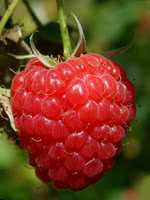Mon-Fri 9am - 5pm Mountain time
Souris Raspberry (an improved Boyne Raspberry) vs Bilberry
Vaccinium myrtillus
Rubus x Souris
CUSTOM GROW
NOT AVAILABLE THIS SEASON - MIGHT RETURN
Bilberry is a native perennial shrub valued for its small, blue-black berries that ripen in mid to late summer. The berries resemble blueberries but have a richer, more tart, and intense flavor. They have long been used for fresh eating, baking, and preserves, while also providing food for birds and mammals. In spring, its delicate pinkish flowers attract bees and other pollinators.
Growing low to the ground, Bilberry forms spreading colonies that create dense understory cover. This growth habit provides food and shelter for wildlife, and its foliage adds seasonal interest by turning red to purple in autumn. With its adaptability and ecological benefits, Bilberry is well-suited for naturalization, ecological restoration, and pollinator gardens.
Souris is an improved version of Boyne, the classic prairie raspberry. It is planted all across Canada and is extremely robust. Where other raspberry cultivars rely on unique selling points and specializations, Souris is just generally a great raspberry.
Souris is cold hardy and resistant to disease and spider mites. Its berries are deliciously sweet and tart while colourful, great for U-pick operations, fresh eating, or using in products such as jams and pies. They can be a bit softer than other raspberry varieties.
The Souris Raspberry is a fast-growing floricane. This means that raspberries will not grow on canes the year they first grow. The mature canes they do grow on, however, produce more berries than primocane varieties.
Bilberry Quick Facts
Souris Raspberry (an improved Boyne Raspberry) Quick Facts
Toxicity: leaves may be unsafe in high doses

